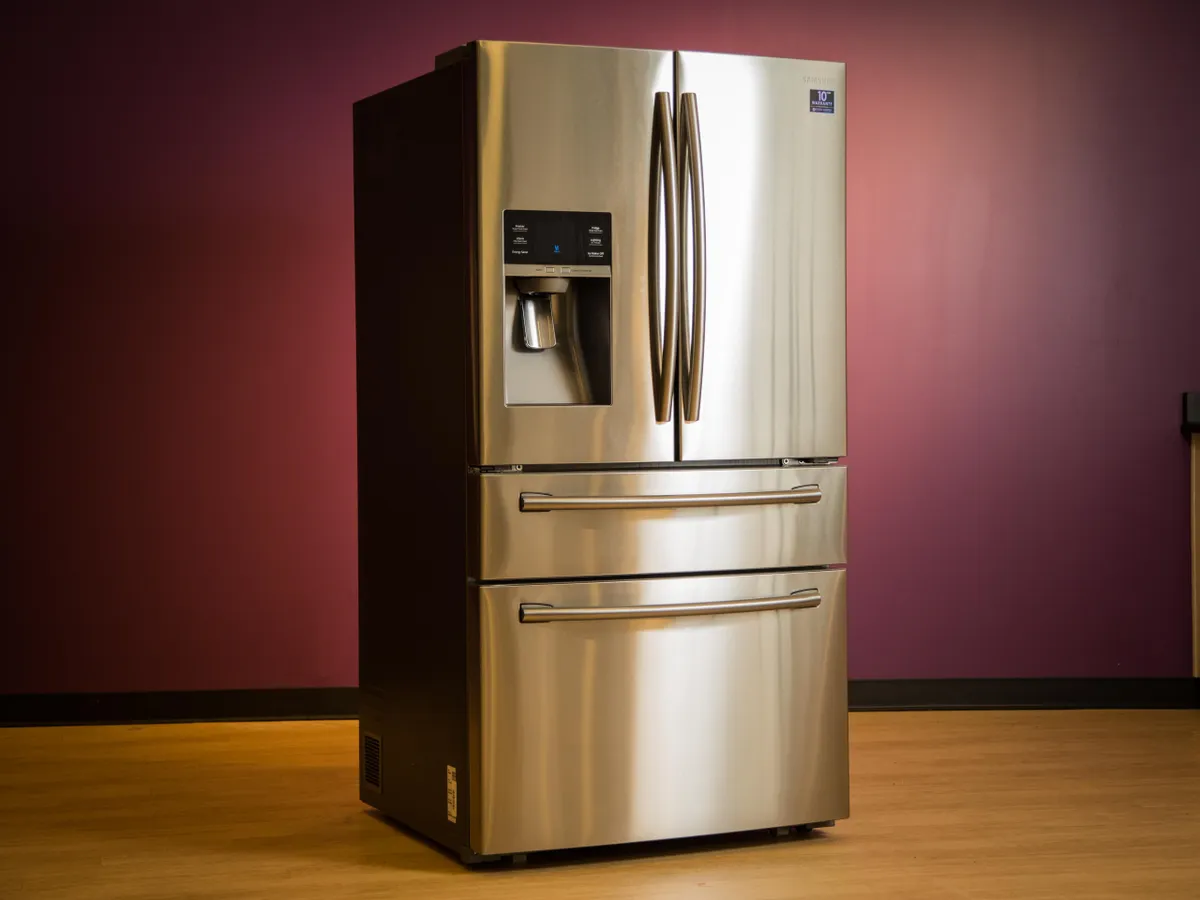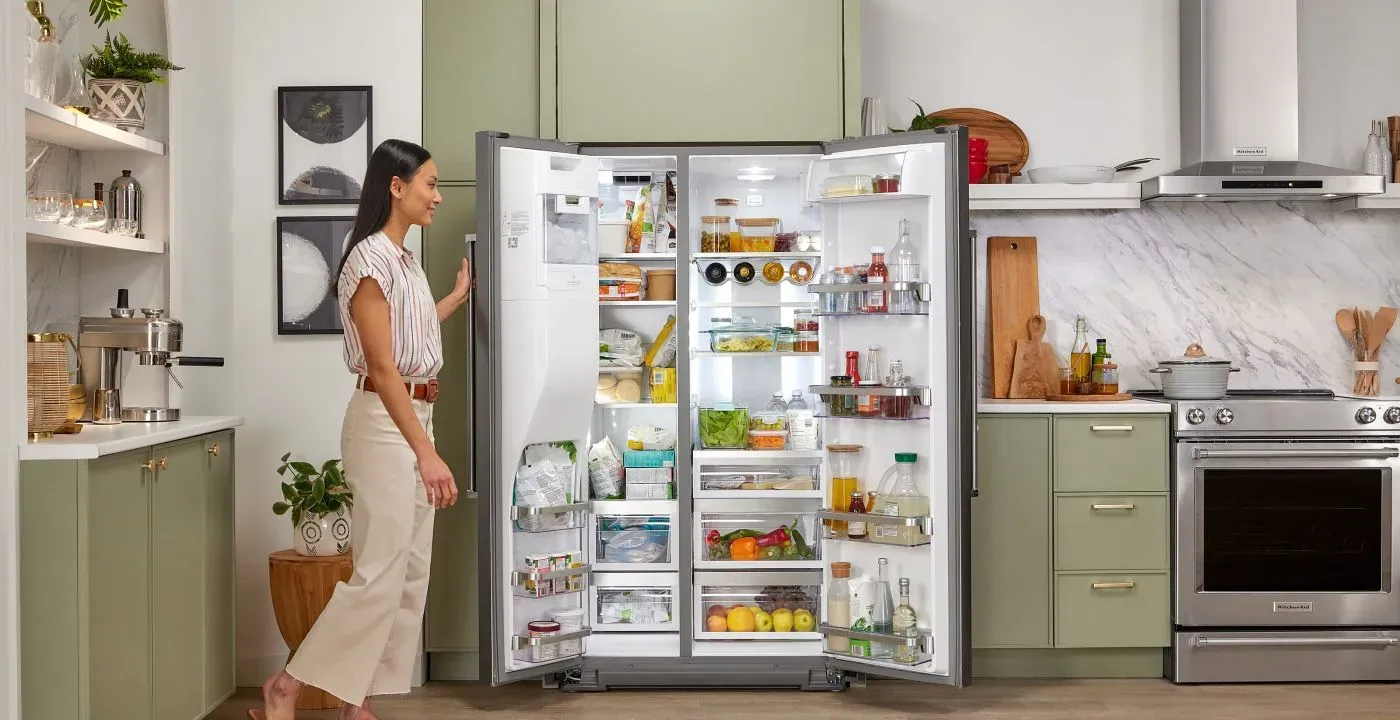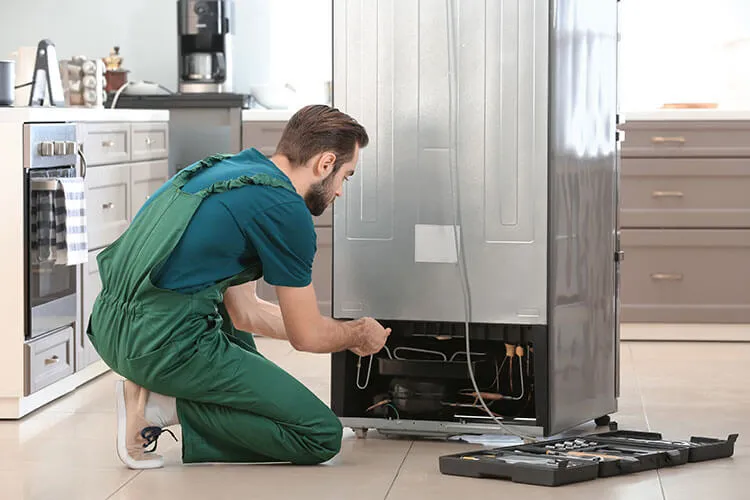
According to the service manual at https://www.manualslib.com/manual/1228428/Samsung-Rf28hmedbsr.html, these are equivalent models:
MODEL NAME :
- RF28HMEDBSR
- RF28HMEDBBC
- RF28HMEDBWW
- RF25HMEDBSR
- RF25HMEDBBC
- RF25HMEDBWW
MODEL CODE :
- RF28HMEDBSR/AA
- RF28HMEDBBC/AA
- RF28HMEDBWW/AA
- RF25HMEDBSR/AA
- RF25HMEDBBC/AA
- RF25HMEDBWW/AA
If your refrigerator model is on the list, the solutions are similar. First, let’s talk about the most likely reason. Quite a few Samsung fridges seem to have this problem where the top part of the evaporator cannot defrost properly, so a giant ball of ice forms, which can prevent the fan from spinning and the fridge compartment from getting cold.
If your refrigerator has this problem, please follow the method in the video to deal with it.
The lasting solution is to attach an extra heating element. You can get the Drain Heater for the Refrigerator on Amazon. click https://amzn.to/41WYtkJ
If your refrigerator is not the cause, we can eliminate them one by one from simple to complex.
Okay, let’s troubleshoot why your Samsung RF28HMEDBSR refrigerator isn’t cooling. This is a common issue with several potential causes, ranging from simple fixes to more complex problems. We’ll go through them step by step.
❗ SAFETY FIRST! ❗ Before inspecting or cleaning inside the back or bottom compartments, ALWAYS unplug the refrigerator from the power outlet to avoid electrical shock.
Here’s a checklist to work through:

- Check the Basics (Simple Fixes):
- Power: Is the refrigerator definitely getting power? Check if the interior lights turn on when you open the doors. Verify it’s plugged in securely. Check your home’s circuit breaker – has it tripped? Try plugging a small lamp into the same outlet to confirm the outlet works.
- Temperature Settings: Double-check the temperature settings on the control panel. Ensure they aren’t accidentally changed to a warmer setting or turned off. For this model, typical settings are around 37°F (3°C) for the fridge and 0°F (-18°C) for the freezer.
- “Demo Mode” or “Shop Mode”: Samsung refrigerators have a mode where the lights work, but the cooling system is disabled (used in stores). To disable Demo Mode, check your user manual (you can find it online if you don’t have it). It often involves pressing a specific combination of buttons on the display panel.
- Door Seals (Gaskets): Are the doors closing completely and sealing correctly? Check for gaps, dirt, or damage on the rubber gaskets around the doors. Warm air leaking in prevents proper cooling. Clean the gaskets with warm soapy water and check if they seal tightly (you can try the “dollar bill test” – close the door on a bill; you should feel resistance when pulling it out).
- Vent Blockages (Inside): Is airflow blocked inside the fridge or freezer compartments? Don’t overpack the fridge, especially in front of the air vents (usually located at the back of the compartments). Cold air needs to circulate freely.
- Clearance (Outside): Ensure the refrigerator has enough space around it for proper ventilation, especially at the back and top (check the manual for specific clearance requirements). The coils need to dissipate heat.

- Listen for Sounds:
- Compressor: Can you hear the compressor running? It’s a low humming or buzzing sound, usually coming from the bottom back of the unit.
- If it’s running constantly but not cooling: This could indicate a refrigerant leak, a restriction in the sealed system, or inefficient heat exchange (like dirty coils).
- If it’s not running at all or just clicks on and off, there could be a problem with the start relay, overload protector, thermostat, control board, or compressor itself.
- Fans: Can you hear any fans running?
- Condenser Fan (near the compressor): This fan blows air over the condenser coils to dissipate heat. If it’s not running, the fridge won’t cool efficiently. Check for obstructions or listen if it’s trying to run.
- Evaporator Fan (usually inside the freezer compartment, behind a panel): This fan circulates cold air from the freezer coils into the freezer and fridge compartments. If it’s not running (or blocked by ice), the fridge section often gets warm first, followed by the freezer. You might need to empty the freezer and remove the back panel inside the freezer (after unplugging it!) to check this.
- Compressor: Can you hear the compressor running? It’s a low humming or buzzing sound, usually coming from the bottom back of the unit.
Things get a little more complicated if none of the above solutions work. Then, we must start from where failures are likely to occur. You can get the Refrigerator Clean Tool on Amazon. click https://amzn.to/4iR1n0g
- Check for Common Issues:
- Dirty Condenser Coils: These coils release heat from the refrigerant. If they are covered in dust, dirt, or pet hair, they can’t effectively dissipate heat, making the fridge work harder and cool poorly.
- Location: Usually at the very back (requiring pulling the fridge out) or underneath (accessed via a removable panel at the back bottom).
- Action: Unplug the fridge. Use a vacuum cleaner with a brush attachment and a coil cleaning brush (long and flexible) to gently clean the coils.
- Excessive Frost Buildup (Evaporator Coils): Modern refrigerators have an automatic defrost system. If this system fails, frost builds up heavily on the evaporator coils (usually behind a panel in the freezer). This ice blocks airflow, preventing cooling.
- Symptoms: Often, the freezer stays somewhat cold, but the fridge gets warm. You might also hear the evaporator fan hitting ice.
- Check: You might need to remove the panel inside the freezer (unplugged!) to see the coils. If they are encased in thick frost/ice, you have a defrost system problem.
- Temporary Fix/Diagnosis: Manually defrost the unit by unplugging it and leaving the doors open for 24-48 hours (place towels to catch melting ice). After plugging it back in, it should cool normally, temporarily. If the problem returns after a week or two, a defrost component (defrost heater, defrost thermostat/bimetal, defrost sensor, or control board) has failed and needs replacement.
- Dirty Condenser Coils: These coils release heat from the refrigerant. If they are covered in dust, dirt, or pet hair, they can’t effectively dissipate heat, making the fridge work harder and cool poorly.
If the problem is not solved, we may need professional maintenance personnel.

- More Complex Issues (Likely Require a Technician):
- Failed Defrost System Components: As mentioned above, if you have excessive frost, the heater, thermostat, sensor, or control board managing the defrost cycle might be faulty.
- Faulty Thermistor (Temperature Sensor): If a sensor fails, it might tell the control board the fridge is colder than it actually is, causing the cooling system to shut off too early.
- Faulty Fan Motor (Evaporator or Condenser): If cleaning doesn’t help and a fan isn’t spinning, the motor might fail.
- Failed Start Relay or Overload Protector: These components help the compressor start. If they fail, the compressor may not run or may click on and off.
- Main Control Board (PCB) Failure: This is the refrigerator’s “brain.” If it fails, it can cause various symptoms, including no cooling.
- Sealed System Problem: This is usually the most serious and expensive issue. It involves the refrigerant gas, compressor, coils, and tubing.
- Refrigerant Leak: Not enough refrigerant to cool correctly.
- Compressor Failure: The pump isn’t working.
- Restriction: A blockage in the tubing prevents refrigerant flow.
Sealed system repairs require specialized tools and EPA certification and must be done by a qualified technician.
Summary & Next Steps:
- Start with the simple checks (Power, Settings, Doors, Vents).
- Unplug the fridge. Clean the condenser coils.
- Listen for the compressor and fans. Check for obstructions.
- Check for excessive frost buildup on the freezer coils (may require removing an internal panel). If found, perform a manual defrost. If it works temporarily, suspect a defrost system part.
- If none of the above works, or if you suspect a fan motor, control board, or sealed system issue, it’s time to call a qualified appliance repair technician. Describe the symptoms you observed (e.g., “compressor runs but no cooling,” “frost buildup,” “no fan sound”).
When you call, provide the technician with your full model number (RF28HMEDBSR). Good luck!
If you can’t set the Samsung fridge temperature correctly, see the URLs.
